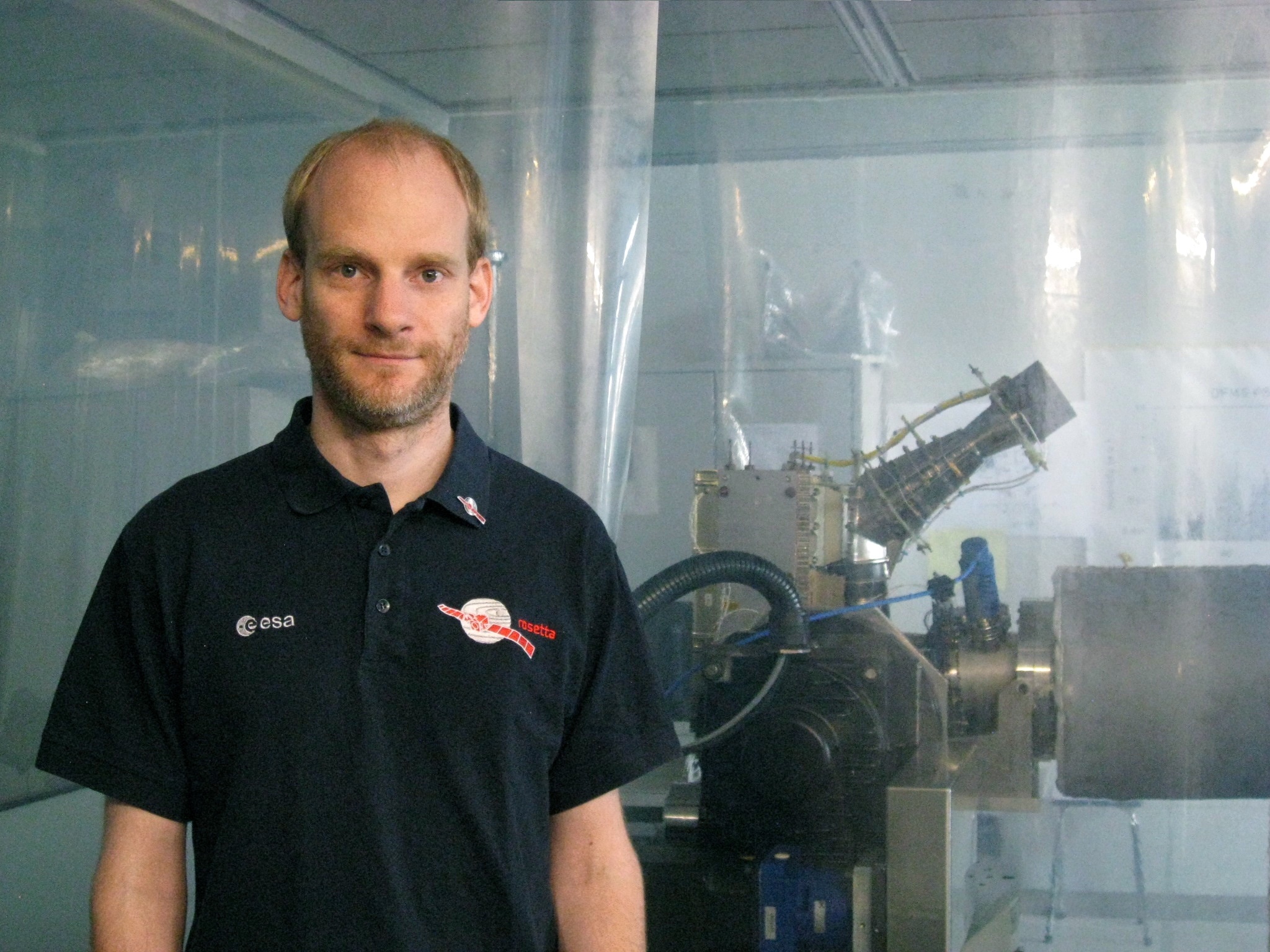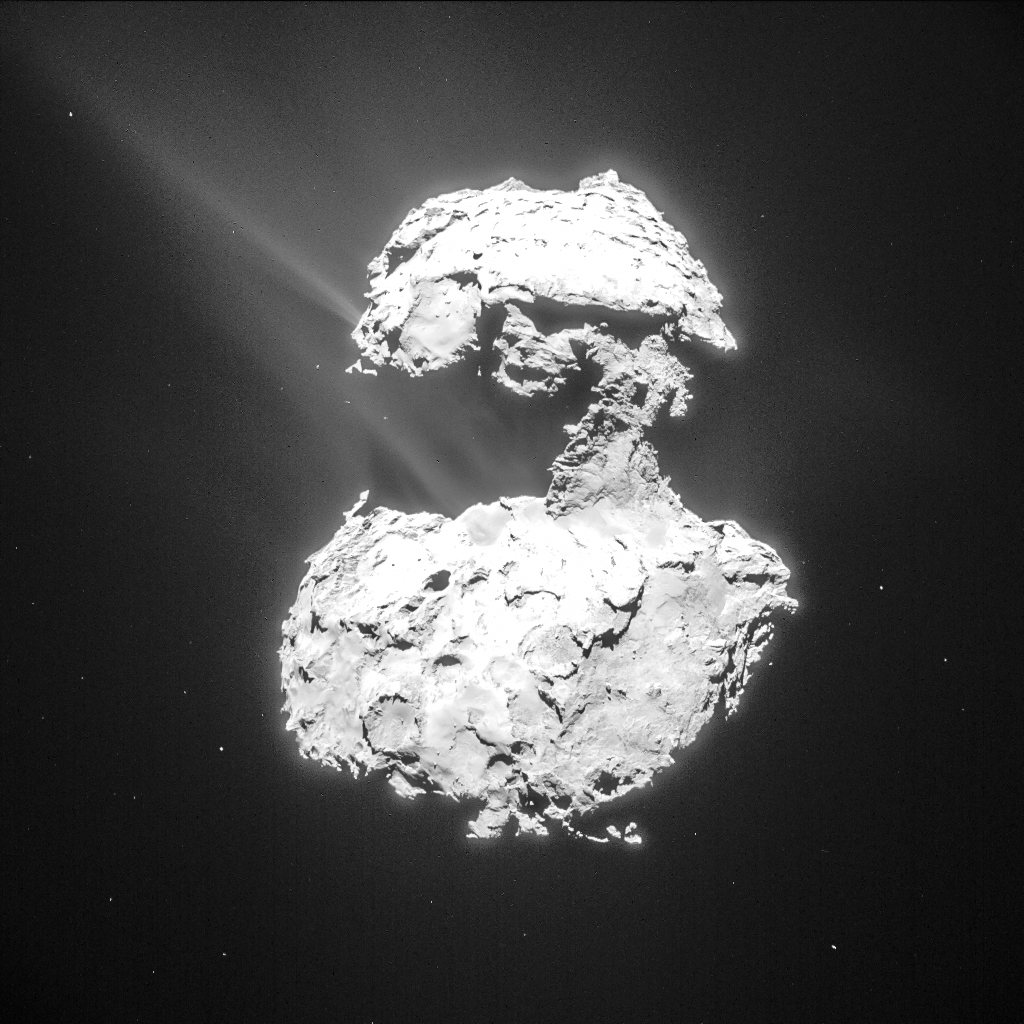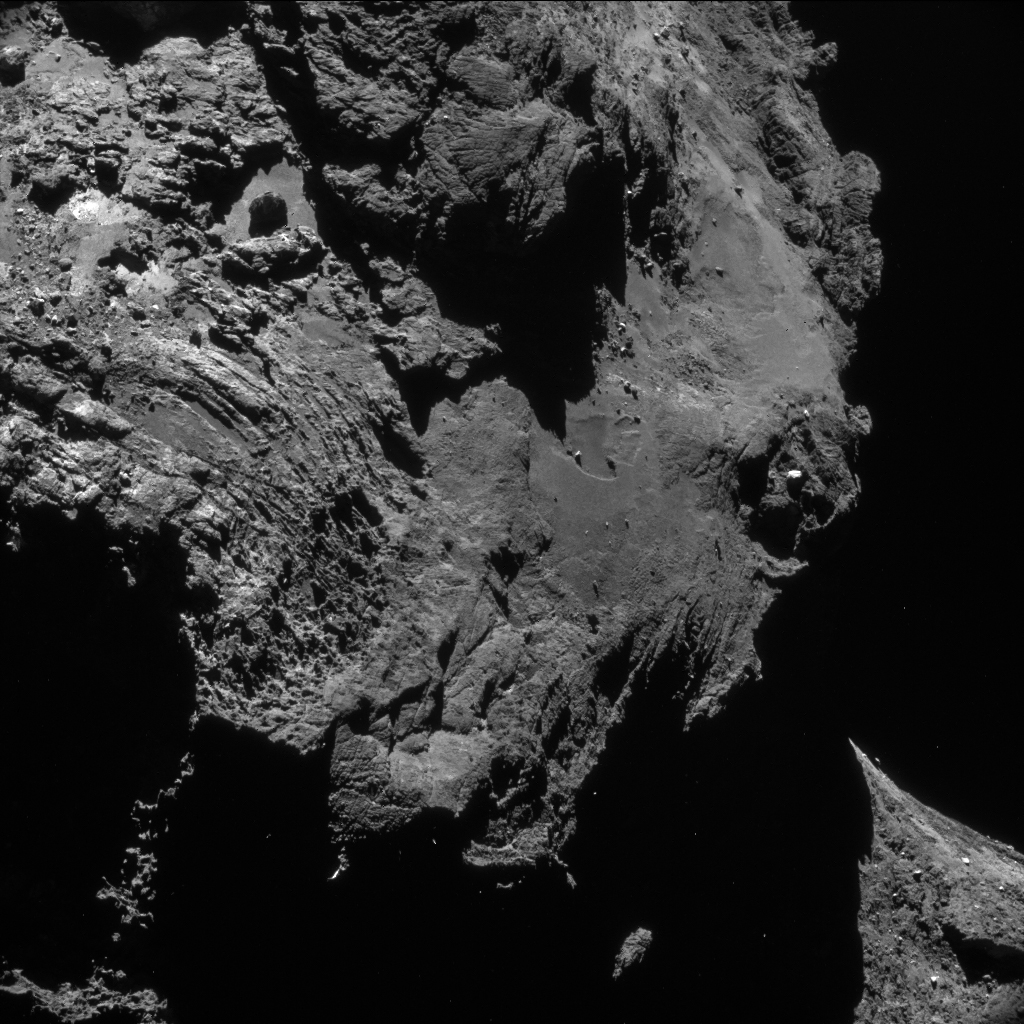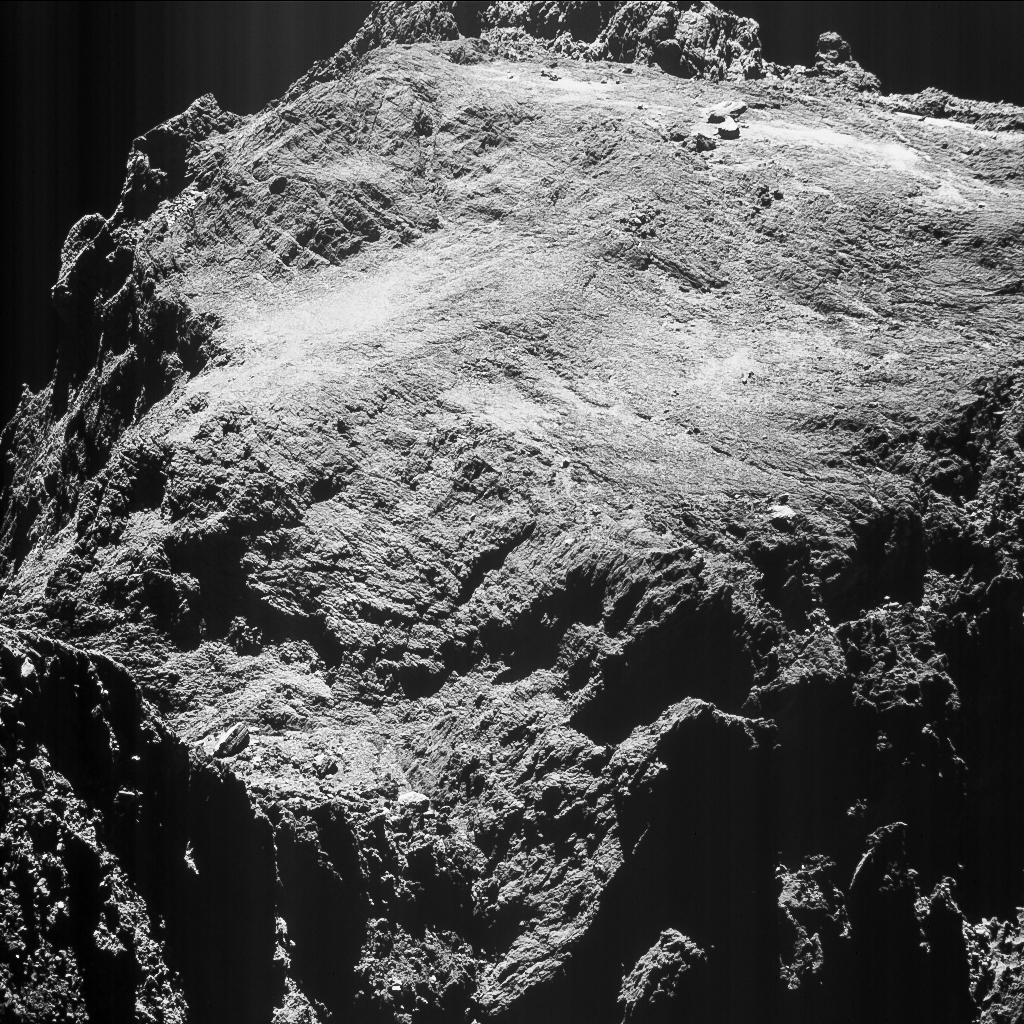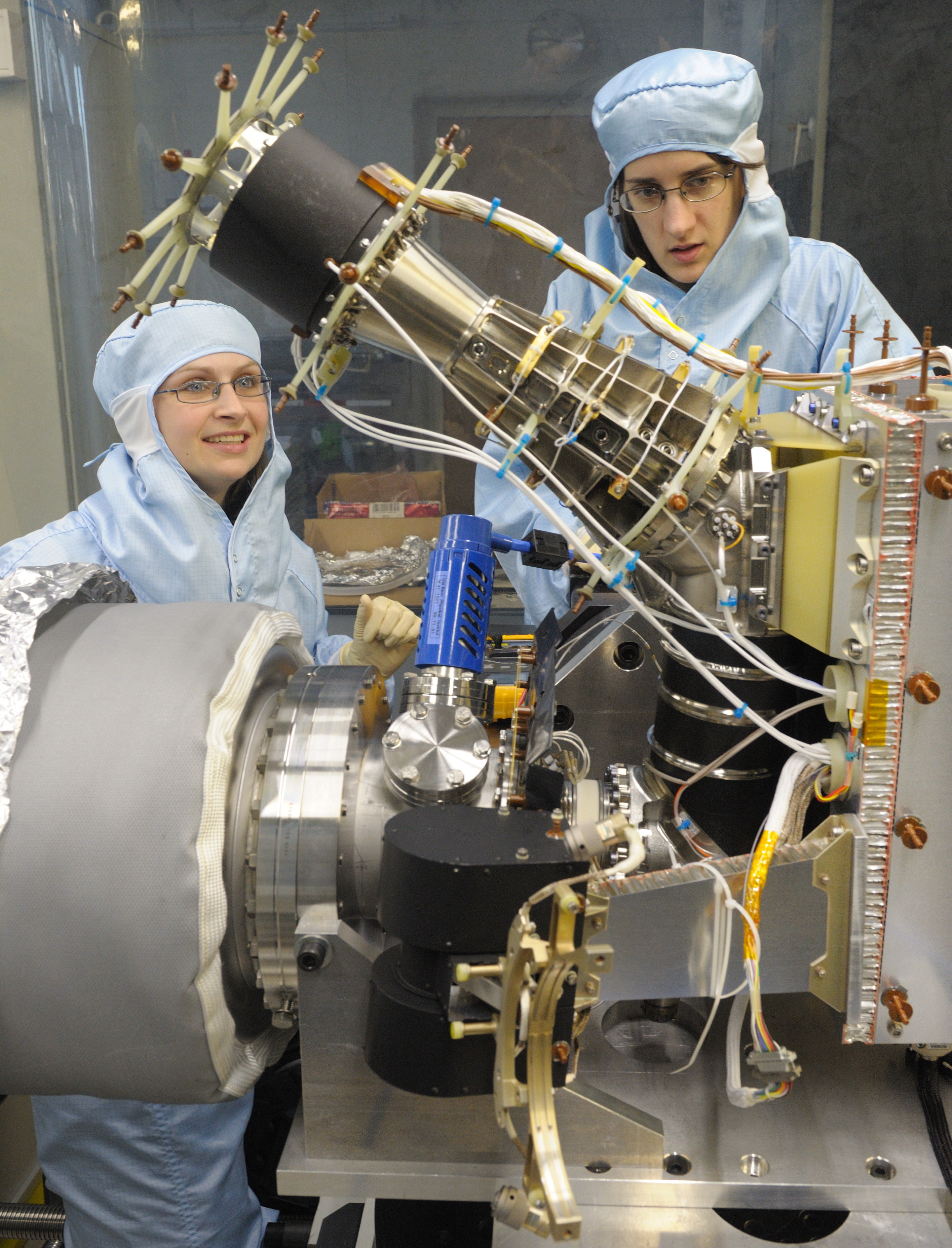Two Years after Rosetta
On September 30, 2016, the active phase of the ESA’s Rosetta mission came to an end with the controlled crash landing of the probe on the surface of the comet Chury. Due to the key experiment of the University of Bern, ROSINA, more information regarding the origin of our solar system was acquired. However, over 2 million data records are still awaiting evaluation.
For more than two years, the European Space Agency (ESA)’s Rosetta mission investigated the comet 67P/Churyumov-Gerasimenko—”Chury” for short—in great detail, even placing the Philae landing module on its surface during the process. What’s more, it was under the leadership of the University of Bern that the ROSINA (the Rosetta Orbiter Spectrometer for Ion and Neutral Analysis) mass spectrometer was developed, built, tested and operated on the comet via telecommand. ROSINA determined many components of Chury’s atmosphere, many of which for the first time on a comet. “The air on the comet would probably be pungent”, was the phrase used by Kathrin Altwegg, ROSINA mass spectrometer project leader, to humorously describe the composition of Chury’s atmosphere.
Water, molecular oxygen and organic compounds
The Rosetta mission was aimed at collecting more information on the origin of our solar system. For example, one of the big questions is how water came to exist on Earth as, in its earliest days, our planet was extremely hot and probably covered with an ocean of lava. Is it possible that comet impacts were responsible for bringing water to Earth at a later date? “Probably not from comets like Chury”, says Kathrin Altwegg. By means of isotopic analysis, a sort of DNA for chemical elements, Altwegg and her team were able to demonstrate that the water on the comet Chury was different from water found on Earth. There are also indications that the ice on the comet is older than our solar system, meaning that this water had already formed in the cold molecular cloud from which our solar system then took shape.
One surprise was the evidence found for molecular oxygen on Chury as, on Earth, this is often associated with life. “But there is no life on the comet”, says Kathrin Altwegg. What’s more, molecular oxygen is very reactive, yet was nevertheless able to withstand billions of years in the comet’s ice. “Entire research teams are currently occupied with how this molecular oxygen came into being, and how it is frozen in the comet’s ice”, explains PD Dr. Martin Rubin, co-investigator in the ROSINA team.
Due to the relative abundance of highly-volatile gases, the researchers were also able to determine the temperature at which the comet was formed. “Chury was formed at around minus 250 degrees Celsius (-418 degrees Fahrenheit), i.e. in the bitter cold” says Martin Rubin, main author of the study at the time.
What’s more, thanks to isotopic analysis, the researchers were able to demonstrate that, if not water, at least a considerable part of the Earth’s atmosphere may have originated from comets. Of particular interest was further the existence of many simple organic compounds, even including the amino acid glycine, which ROSINA was able to detect. “The amount of organic compounds on Chury is considerable, which opens up the possibility that comet impacts may have facilitated the emergence of life on Earth.” says Kathrin Altwegg.
Over 2 million data records await evaluation
The end of the Rosetta mission and, with it, the end of ROSINA’s measurements, by no means meant the end of research work. “We have over 2 million data records,” emphasizes Kathrin Altwegg, “and many of them have not been evaluated yet”. This work should continue to keep the researchers busy for years. “Our chief goal is the analysis of the data; after all, that’s why we flew to Chury in the first place” says Martin Rubin.
The ESA is financed by its member states, including Switzerland. Accordingly, this data also belongs to the general public. “The raw data as it was measured by ROSINA and sent back to Earth is already available to the public” says Martin Rubin. Currently, the team is working on further preparing this data so that it is easier to analyze and so that it can also be used to some extent by researchers who do not have a background in mass spectrometry. The data will be available on the ESA server in a few months’ time and will be able to be downloaded without having to register.
Against this backdrop, Kathrin Altwegg would particularly like to thank the sponsors, the
State Secretariat for Education, Research and Innovation SERI, the Swiss National Science Foundation (SNSF) and the canton of Bern for their support over the years: “Rosetta/ROSINA would never have achieved the success it did without this strong support”.
Comets: Messengers from the earliest days of our solar systemComets are objects from the depths of our solar system: They are relics from the formation of the sun, planets, and moons. They have generally spent most of their time far away in the “Kuiper Belt” outside the orbit of dwarf planet Pluto, or in the Oort cloud, which extends to the edge of our solar system. Correspondingly, their composition is still very primordial. It is only when the orbits of these objects are disturbed and that they are diverted towards the sun that they are called comets. When in proximity to the sun, the ice contained within the comet evaporates which, together with dust, forms the well-known tail. It is precisely these gases which the researchers in Bern have been researching with their mass spectrometer, ROSINA. |
Details about the publications:Altwegg, K., Balsiger, H., Berthelier, J. J., Bieler, A., Calmonte, U., De Keyser, J., Fiethe, B., Fuselier, S. A., Gasc, S., Gombosi, T. I., Owen, T., Le Roy, L., Rubin, M., Sémon, T., Tzou, C. Y., 2017. D2O and HDS in the coma of 67P/Churyumov–Gerasimenko. Philosophical Transactions of the Royal Society A: Mathematical, Physical and Engineering Sciences. 375. Altwegg, K., Balsiger, H., Bar-Nun, A., Berthelier, J. J., Bieler, A., Bochsler, P., Briois, C., Calmonte, U., Combi, M. R., Cottin, H., De Keyser, J., Dhooghe, F., Fiethe, B., Fuselier, S. A., Gasc, S., Gombosi, T. I., Hansen, K. C., Haessig, M., Jäckel, A., Kopp, E., Korth, A., Le Roy, L., Mall, U., Marty, B., Mousis, O., Owen, T., Reme, H., Rubin, M., Semon, T., Tzou, C. Y., Hunter Waite, J., Wurz, P., 2016. Prebiotic chemicals-amino acid and phosphorus-in the coma of comet 67P/Churyumov-Gerasimenko. Sci Adv. 2, e1600285. Bieler, A., Altwegg, K., Balsiger, H., Bar-Nun, A., Berthelier, J. J., Bochsler, P., Briois, C., Calmonte, U., Combi, M., De Keyser, J., van Dishoeck, E. F., Fiethe, B., Fuselier, S. A., Gasc, S., Gombosi, T. I., Hansen, K. C., Hässig, M., Jäckel, A., Kopp, E., Korth, A., Le Roy, L., Mall, U., Maggiolo, R., Marty, B., Mousis, O., Owen, T., Reme, H., Rubin, M., Semon, T., Tzou, C. Y., Waite, J. H., Walsh, C., Wurz, P., 2015. Abundant molecular oxygen in the coma of comet 67P/Churyumov-Gerasimenko. Nature. 526, 678-81. Fayolle, E. C., Öberg, K. I., Jørgensen, J. K., Altwegg, K., Calcutt, H., Müller, H. S. P., Rubin, M., van der Wiel, M. H. D., Bjerkeli, P., Bourke, T. L., Coutens, A., van Dishoeck, E. F., Drozdovskaya, M. N., Garrod, R. T., Ligterink, N. F. W., Persson, M. V., Wampfler, S. F., 2017. Protostellar and cometary detections of organohalogens. Nature Astronomy. 1, 703-708. Drozdovskaya, M. N., van Dishoeck, E. F., Jørgensen, J. K., Calmonte, U., van der Wiel, M. H. D., Coutens, A., Calcutt, H., Müller, H. S. P., Bjerkeli, P., Persson, M. V., Wampfler, S. F., Altwegg, K., 2018. The ALMA-PILS survey: the sulphur connection between protostars and comets: IRAS 16293–2422 B and 67P/Churyumov–Gerasimenko. Monthly Notices of the Royal Astronomical Society. 476, 4949-4964. Marty, B., Altwegg, K., Balsiger, H., Bar-Nun, A., Bekaert, D. V., Berthelier, J. J., Bieler, A., Briois, C., Calmonte, U., Combi, M., De Keyser, J., Fiethe, B., Fuselier, S. A., Gasc, S., Gombosi, T. I., Hansen, K. C., Hässig, M., Jäckel, A., Kopp, E., Korth, A., Le Roy, L., Mall, U., Mousis, O., Owen, T., Rème, H., Rubin, M., Sémon, T., Tzou, C. Y., Waite, J. H., Wurz, P., 2017. Xenon isotopes in 67P/Churyumov-Gerasimenko show that comets contributed to Earth’s atmosphere. Science. 356, 1069. Rubin, M., Altwegg, K., Balsiger, H., Bar-Nun, A., Berthelier, J. J., Bieler, A., Bochsler, P., Briois, C., Calmonte, U., Combi, M., De Keyser, J., Dhooghe, F., Eberhardt, P., Fiethe, B., Fuselier, S. A., Gasc, S., Gombosi, T. I., Hansen, K. C., Hassig, M., Jäckel, A., Kopp, E., Korth, A., Le Roy, L., Mall, U., Marty, B., Mousis, O., Owen, T., Reme, H., Semon, T., Tzou, C. Y., Waite, J. H., Wurz, P., 2015. Molecular nitrogen in comet 67P/Churyumov-Gerasimenko indicates a low formation temperature. Science. 348, 232-5. |
2018/09/28
